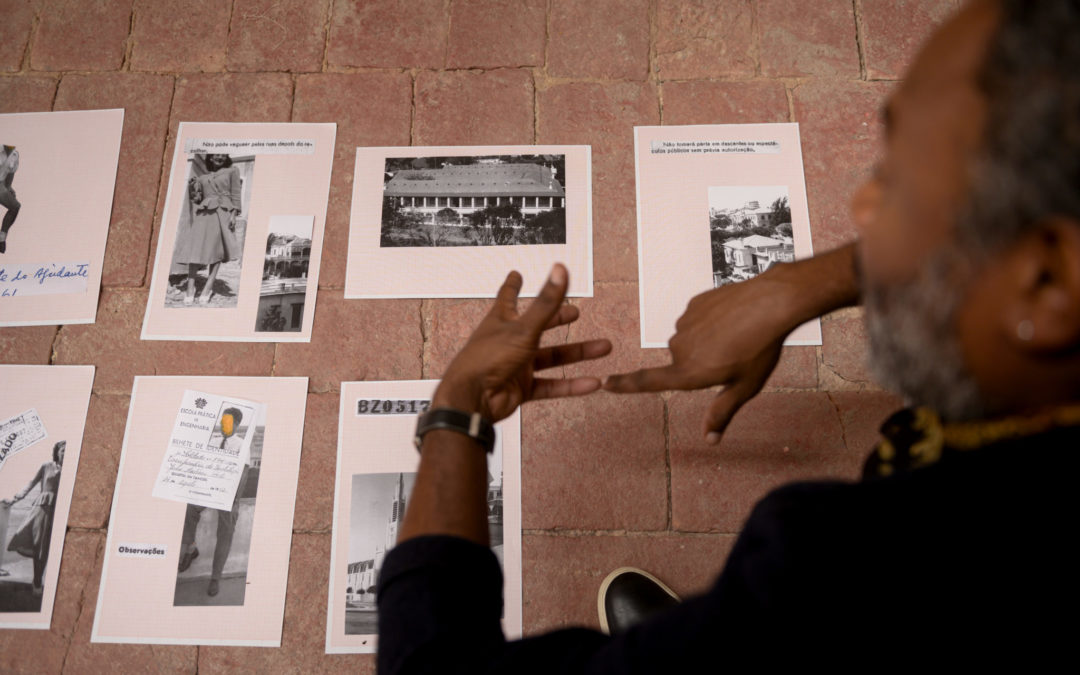Born in Luanda, Angola and based in Milan, visual artist Délio Jasse (CRF 2022) explores history and memory by interweaving found photographs and documents with his own artistic processes and annotations. Délio spoke with Program Assistant Greta Caseti on the importance of recognizing Black History Month in Italy, reviving negated histories through art, and his approach to working with colonial and Afro-diasporic narratives. Read below for his reflections in Italian and English.
Nato a Luanda, in Angola, e attualmente residente a Milano, l’artista Délio Jasse (CRF 2022) riflette sulla storia e sulla memoria, intrecciando fotografie e documenti con i suoi processi artistici.
Délio ha parlato con la nostra Program Assistant Greta Caseti dell’importanza di osservare il Black History Month anche in Italia, e di riscoprire le storie dimenticate e negate tramite l’arte, descrivendo anche il suo approccio alla narrativa coloniale e alla diaspora Africana. Continua a leggere per l’intervista in italiano e in inglese.
See here for more on his current and upcoming projects: https://deliojasse.com/
Italiano:
Il Black History Month è una ricorrenza americana, qual è l’importanza di parlarne anche in Italia e di declinare questo mese sulla nostra storia? E qual è l’importanza di collegare la storia Afro-Italiana a quella della diaspora africana internazionale?
Il Black History Month deve farci riflettere su tutto ciò che non si dice e di cui non si parla, specialmente sulla storia dell’Africa coloniale che troppo spesso rimane nell’ombra. Celebrare il Black History Month in Italia vuole restituire un respiro alle troppe storie rimosse, ignorate, sepolte e far capire quanto la storia afro-italiana e quella della diaspora africana internazionale sono strettamente interconnesse.
La tua pratica artistica include fotografie, immagini e documenti per far riflettere sulla storia coloniale italiana. Quanto è centrale la memoria nel tuo lavoro?
Nel mio lavoro la memoria è fondamentale perché va a evidenziare il passato nascosto e addirittura negato della comunità nera africana. Il mio compito in quanto artista è andare a svelare e divulgare la memoria di questa comunità e per farlo non uso le fotografie che si trovano sui libri di storia, ma vado a cercare i documenti e le fotografie personali della gente, quelle che sono di solito custodite all’interno delle case, nelle scatole da scarpe e negli armadi. Questi oggetti diventano forme di memoria ancestrale che dimostrano l’esistenza di un’altra narrativa rispetto a quella che ci viene raccontata nei libri di storia, una narrativa fatta di singoli individui, di storie e legami intimi. Il mio è un lavoro di post-memory che vuole fornire una rimappatura e una reimmaginazione di quelle storie dell’Africa orientale. La mia arte vuole attribuire un nuovo significato alle immagini, andando ad alterare la loro forma visiva originale, con l’obiettivo di cambiarne la percezione narrativa.
Cosa ti porterà il 2023 lavorativamente e artisticamente parlando?
Il 2023 sarà un anno pieno di impegni. Avrò diverse mostre tra Portogallo, Londra e Italia. Ma il progetto che sento di più è quello in Angola, dove si svolgerà la mia prima esibizione personale a giugno. Questo è un passo importantissimo per la mia carriera perché ho sempre sentito il dovere di portare la mia arte nel mio paese e finalmente lo farò.
English:
Black History Month is a U.S. celebration. Why is it meaningful to recognize it in Italy, and to think about our own history throughout this month? And why is it important to connect Afro-Italian history with that of the international African diaspora?
Black History Month should make us reflect on all that we don’t say, that we don’t talk about, especially on the history of colonialism in Africa, which is too often kept in the shadows. Celebrating Black History Month in Italy is an attempt to revive the all-too-many stories that have been cast aside, ignored, buried, and to show how tightly interconnected Afro-Italian history and the history of the international African diaspora are.
Your artistic practice involves using photographs, images, and documents to reflect on Italian colonial history. How central is memory to your work?
Memory is fundamental to my work, because it is what brings out the hidden, really the negated, past of the Black African community. My job as an artist is to go and uncover and share the memory of this community, and to do that I don’t use photos from history books, I look for people’s personal documents and photographs, the ones kept in their homes, in shoeboxes and closets. These effects become a kind of ancestral memory, that prove the existence of an alternative narrative to the ones in history books, a narrative made by individuals, stories, bonds, and kinships. My work is one of post-memory, and it seeks to remap and reimagine the story of eastern Africa. My art tries to give new meaning to the images, by changing their original visual forms in order to change the perception of the narrative.
What is 2023 bringing, artistically and professionally, for you?
2023 is a busy year. I have shows in Portugal, London and Italy. But the project I am most looking for is in Angola, where I’ll be having my first solo show in June. This is a huge step for my career, because I have always wanted to be able to bring my art to my home country, and I am finally going to.
